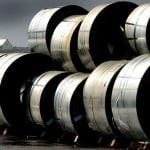On 9 October, Brickwork Ratings India Pvt. Ltd downgraded non-convertible debentures (NCDs) worth Rs.484 crore issued by Amtek Auto to a D rating because of delays in servicing debt. Instruments with this rating are in default or are expected to be in default. The revision was on account of delays in the servicing of coupon to debenture holders due on 1 October. There had been a rapid deterioration in the rating. Brickworks’ July 2015 rating of Amtek was A+, dropping to C in August and finally D in October.
Care Ratings suspended its ratings in August following the company’s failure to furnish information required for monitoring the rating. Till April, Amtek enjoyed AA rating for its bonds as well as long-term bank debt and A1+ rating for short-term bank debt from Care. In May, the bonds and long-term bank debt ratings were brought down a notch, but the short-term loan continued to enjoy A1+ rating. A 27 May Care note said, “The ratings … continued to deliver strength from the experience and the resourcefulness of the promoters.”
In medical parlance, it was like detecting stage IV cancer in a patient all of a sudden. The only difference is—a patient needs to go to a doctor but rating agencies are expected to monitor the companies on their own. It seems that they did not smell the rot.
Incidentally, Crisil Ltd, a Standard & Poor’s company, too gave the highest rating to the JP Morgan fund that had Amtek paper in its portfolio. It had assigned the AAAmfs rating to the JP Morgan India treasury scheme in May, signifying the highest portfolio credit quality. Such a rating is normally arrived at after examining the ratings of the outstanding portfolio of a mutual fund. The methodology of assigning ratings to a mutual fund scheme is typically based on shadow ratings of the papers of the companies in which the fund has invested and the ratings of which may not be available in the public domain.
In August, after the public ratings of the automotive components firm were either suspended or downgraded by other raters, Crisil revised the scheme rating in three stages over two months: first, on 1 September, it downgraded it from AAAmfs to A+mfs and then, on 29 September, to BBBmfs (overall, an eight-notch downgrade in one month), and then on 15 October, it placed the scheme on the so-called “notice of withdrawal”.
What has Amtek been doing to get out of the mess? First, in September, $80 million worth of foreign currency convertible bonds (FCCBs), floated by Castex Technologies Ltd, got converted into equity, giving breathing space to the group. Or, so it thought.
The FCCB holders have written to India’s capital markets regulator Securities and Exchange Board of India (Sebi) and the bourses, saying the prices of Castex Technologies shares were artificially pushed up for a certain period of time, triggering a clause in the agreement that permits the company to enforce the conversion of FCCBs into equity. The clause states that if the Castex share trades at a price higher than approximately Rs.160 for a period of one month, the company can enforce conversions. Castex shares rose from a low of Rs.40 in March to consistently trade above Rs.160 a share between June and August, reaching a peak of Rs.360 in July, inducing the conversion of the FCCBs. However, after August, the price is back to Rs.40 per share.
Although a Sebi investigation is underway, recent media reports indicate that the ongoing investigation has not yet found any evidence of market manipulation.
Bank exposure to the group
As on 31 May, a group of 19 banks had major exposure to the group in the form of term loans, besides many other banks that had given working capital loans and foreign currency loans and subscribed to its bonds. The consortium had sanctioned Rs.3,795 crore worth of term loans and disbursedRs.3,329.26 crore. IDBI Bank Ltd and State Bank of India (SBI) are the leaders of the consortium. IDBI Bank sanctionedRs.450 crore and disbursed Rs.262 crore. SBI sanctioned and disbursed Rs.350 crore. Others include State Bank of Bikaner and Jaipur (Rs.220 crore sanctioned and Rs.150 crore disbursed, respectively), Canara Bank (Rs.300 crore, fully disbursed), IFCI Ltd (Rs.350 crore), Life Insurance Corp. of India (Rs.300 crore), State Bank of Mysore, State Bank of Patiala and Bank of Baroda (Rs.200 crore each), Oriental Bank of Commerce, Allahabad Bank and ICICI Bank Ltd (Rs.150 crore each).
Additionally, Amtek had sold bonds worth Rs.1,930 crore. TheRs.800 crore default is part of this.
IDBI Bank, Canara Bank, Punjab National Bank, Bank of Baroda and a few others have exposure to Amtek to the tune of $350 million worth of foreign currency loans, with IDBI Bank having the maximum exposure, $185 million.
IDBI Bank has also given the Amtek group working capital loans, albeit in a small quantity, Rs.47.50 crore out of Rs.1,597 crore. Corporation Bank, Andhra Bank and Indian Overseas Bank together account for the rest.
Then, there is a group of unsecured creditors too, mostly foreign banks such as Deutsche Bank AG, Credit Agricole SA, Citibank NV, Standard Chartered Bank Plc, Bank of Nova Scotia, among others. The total exposure here is a little over $163 million. Two Indian entities on this list are Kotak Mahindra Bank Ltd and Yes Bank Ltd.
None of the banks have classified its exposure to Amtek as a bad loan and hence not provided for it. Amtek has managed to keep its outstanding dues to within 90 days—and continues to do so. Which is why almost all the lenders have classified Amtek as SMA-2, or special mention account.
The SMA-2 category refers to those accounts where the principal or interest payment is overdue for 61-90 days. This is the third stage in an account’s progress to becoming a non-performing asset, or NPA, after SMA-0 (where the principal or interest payment is not overdue for more than 30 days but the account shows signs of incipient stress) and SMA-1 (where the principal or interest payment is overdue for 31-60 days). Once a borrower is not able to service the account for 90 days, it becomes an NPA and the lenders need to set aside money for such an account.
Once a loan account worth Rs.5 crore or more is classified as SMA, banks are expected to report all relevant data to the Central Repository of Information on Large Credits, set up by the Reserve Bank of India (RBI). In accordance with RBI norms, when a loan account starts showing signs of stress, bankers are required to create a Joint Lenders’ Forum (JLF) to chalk out an action plan. The creation of a JLF is mandatory when a relatively large account—with an exposure of at least Rs.100 crore—is categorized as SMA-2, even as the lenders always have the option of setting up the forum for smaller accounts.
If the existing promoters are not in a position to bring in additional money or take any measures to regularize the account, the JLF can explore the possibility of getting new investors in the company in consultation with the borrower. The account can be restructured if it is prima facie viable and the borrower is not a wilful defaulter, who has resorted to fund diversion. If these two options are not feasible, the JLF can initiate a recovery process. All decisions of the JLF need to be endorsed by a minimum of 75% of lenders by value and 60% by number.
The Amtek management has indicated to the banks that the majority of lenders have agreed to the proposal under the JLF and received internal approvals for rollovers, interest financing, etc. It is urging others to give their approval to get it going. According to Amtek, the delay in completion of the financing is because the group has had to deal with multiple banks on a one-on-one basis and that has taken time, although the recent RBI guidelines in this regard are helpful and will speed up the process.
Three group firms are involved in debt restructuring: Amtek Auto, Ahmednagar Forging and Castex Technologies. IDBI Bank is leading the discussion on Amtek Auto, while SBI is leading on Ahmednagar Forging and Castex Technologies. The discussions have been veering around the restructuring of the group debt in two parts—the infusion of funds by its promoter and the banks to take care of immediate working capital needs and the recasting of existing debt by extending maturity to 10 years, including a two-year payment holiday. This is to take care of the firm’s tight liquidity situation.
As a precondition for pumping in Rs.1,250 crore of fresh loans, the banks are asking the promoters to infuse Rs.220 crore. So far, the promoters have infused Rs.75 crore as part of their contribution. For additional cash infusion, the promoters may need to rely on the sale of their interests in other businesses, including food, hospitality and real estate.
Given that the domestic business performance has not yet shown signs of revival, the company has very little option but to rely on divestitures to pare its debt. It has appointed Morgan Stanley to evaluate sale options for international assets as well as for a significant minority position (up to 40%) in its international business holding company. Media reports suggest that Amtek Auto might end up selling Tekfor, the German forging company it had acquired in 2013, for Rs.6,000 crore.
The lesson for the bankers
What are the lessons for the bankers from the Amtek story? Nothing can substitute close monitoring of the businesses of a borrower. In this case they did not do that. How could a company keep on building capacity when there was no demand and when it has been on a buying spree overseas supported by debt from domestic banks? A loan restructuring may give them temporary relief and postpone the inevitable, unless promoter Arvind Dham is serious about going to the Himalayas and selling off all non-core businesses and some of the overseas assets to clean up the balance sheet.
Even if a bankruptcy law comes into force and banks are empowered to take over a company, they do not have the expertise to run it. And if they make use of the current strategic debt restructuring programme, which gives them the right to change the management of a stressed company, who will run such units?
Bhushan Steel Ltd is a case in point. Banks have a collective exposure of Rs.35,000 crore to the steel company and it is now an Albatross hanging around their necks. Along with project appraisal, risk management and strict monitoring, Indian banks also need to develop the outsourcing skills to run companies if they need to clean up their balance sheets of bad loans.
[“source -livemint”]





